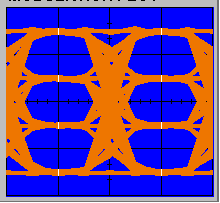Eye pattern

In telecommunication, an eye pattern, also known as an eye diagram is an oscilloscope display in which a digital data signal from a receiver is repetitively sampled and applied to the vertical input, while the data rate is used to trigger the horizontal sweep. It is so called because, for several types of coding, the pattern looks like a series of eyes between a pair of rails.
Several system performance measures can be derived by analyzing the display. If the signals are too long, too short, poorly synchronized with the system clock, too high, too low, too noisy, too slow to change, or have too much undershoot or overshoot, this can be observed from the eye diagram. An open eye pattern corresponds to minimal signal distortion. Distortion of the signal waveform due to intersymbol interference and noise appears as closure of the eye pattern.
In summary:
| Eye-diagram feature | What it measures |
|---|---|
| Eye opening (height, peak to peak) | Additive noise in the signal |
| Eye overshoot/undershoot | Peak distortion |
| Eye width | Timing synchronization & jitter effects |
See also
References
- Christopher M. Miller "High-Speed Digital Transmitter Characterization Using Eye Diagram Analysis". 1266 Hewlett-Packard Journal 45(1994) Aug., No,4, pp. 29-37.
- Federal Standard 1037C
- US Military standard MIL-STD-188
- John G Proakis, Digital Communications 3rd ed, 2001
